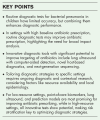Diagnostic testing and antibiotic stewardship for pneumonia in children worldwide: current developments and next steps
- PMID: 40531490
- PMCID: PMC12422624
- DOI: 10.1097/MOP.0000000000001484
Diagnostic testing and antibiotic stewardship for pneumonia in children worldwide: current developments and next steps
Abstract
Purpose of review: Routine diagnostic tests for childhood pneumonia lack the accuracy to identify bacterial pneumonia, leading to inappropriate antibiotic prescription. Novel tests are being developed. Optimizing diagnostic strategies using available diagnostic tools and exploring the role of new tests is essential to improve antimicrobial stewardship (AMS) in children. This review provides an overview of advances in diagnostic testing for pediatric pneumonia and discusses how strategies can be optimized in different settings in order to improve AMS.
Recent findings: All currently available tests for bacterial pneumonia are limited in their diagnostic accuracy. However, in settings with high baseline antibiotic prescription, routine diagnostics such as CRP or PCT-guided prescription can improve antibiotic use. Among the innovative tests, lung ultrasound with computer-aided detection and prediction models combining multiple tests holds most promise for low-resource settings. For high-resource settings, RNA signatures and next-generation sequencing are promising developments. The impact of innovative tests on AMS remains to be evaluated.
Summary: Robust diagnostic and contextual research is needed to develop new diagnostic tests and to optimize current strategies for bacterial pneumonia in children. In order to tailor diagnostic approaches to specific settings, broad impact studies and stratification of risk groups are crucial.
Keywords: antimicrobial stewardship; bacterial infection; diagnostic tests; pneumonia; respiratory tract infections.
Copyright © 2025 The Author(s). Published by Wolters Kluwer Health, Inc.
Conflict of interest statement
Figures
References
-
- Integrated management of childhood illness. World Health Organization; 2014.
-
- Horvath AR, Lord SJ, StJohn A, et al. From biomarkers to medical tests: the changing landscape of test evaluation. Clin Chim Acta 2014; 427:49–57. - PubMed
-
- Keitel K, D’Acremont V. Electronic clinical decision algorithms for the integrated primary care management of febrile children in low-resource settings: review of existing tools. Clin Microbiol Infect 2018; 24:845–855. - PubMed
Publication types
MeSH terms
Substances
LinkOut - more resources
Full Text Sources
Medical
Research Materials
Miscellaneous



